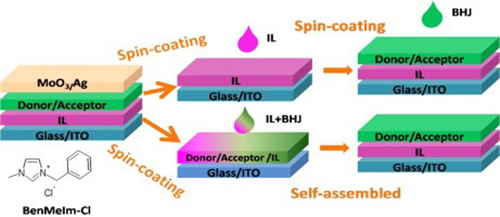The interlayer inserted between active layer and ITO has been a key issue for improving electron extraction in inverted polymer solar cells (IPSCs), while the ideal interlayer for IPSCs has not been well developed. In this work, we presented a spontaneous vertical phase separation (SVPS) self-assembled bilayers structure with BenMeIm-Cl ionic liquid (IL) interfacial bottom layer and a photoactive top layer via a single spin-coated step of BenMeIm-Cl IL and organic donor–acceptor composite and achieved a PCE as high as 8% based on IPSCs with PTB7 as the donor. The presence of BenMeIm-Cl IL reduces the work function of ITO and leads to a better energy-level matching for efficient charge-transfer. The driving force of SVPS self-assembled structure is from the relative surface energy difference between organic materials and BenMeIm-Cl ILs, together with their interactions with the substrates. This self-assembled process procedure pave the way to simplify the manufacturing of low-cost and large-area organic electronic devices. (Nano Energy, 2015, 13, 275-282)

In our another work, we find that ionic liquid (IL) can significantly enhance the efficiency of i-PSCs. With ZnO/IL interfacial layer, PTB7-Th:PC71BM i-PSCs can result a champion power conversion efficiency (PCE) of 10.15%, which is among the highest PCE reported thus far for single-junction bulk heterojunction solar cells through solution-process. The IL layer and ZnO/IL combination layer with low work function, good optical transmittance, improved electron extraction and reduced resistance at the cathode interface, has been demonstrated to be an excellent and general interfacial layer for i-PSCs. (J. Mater. Chem. A, 2015, DOI: 10.1039/C5TA00930H)
